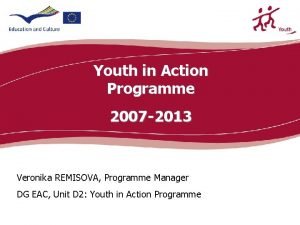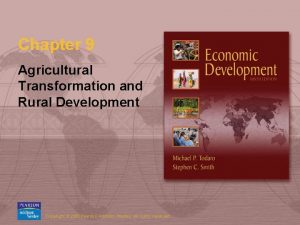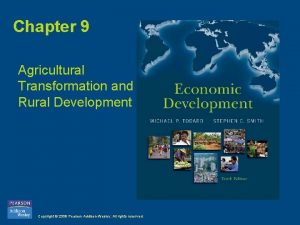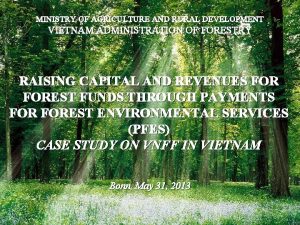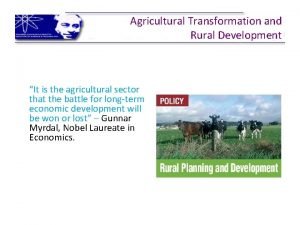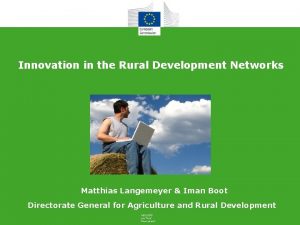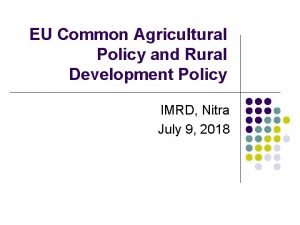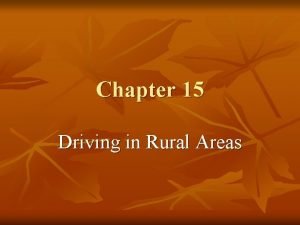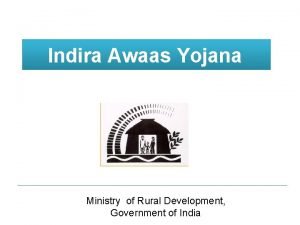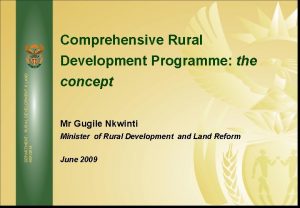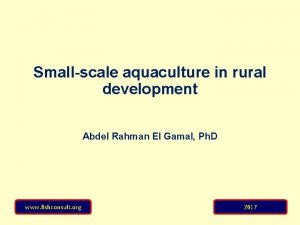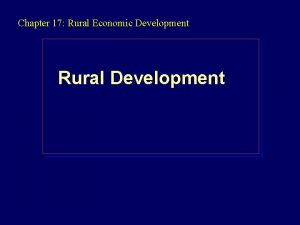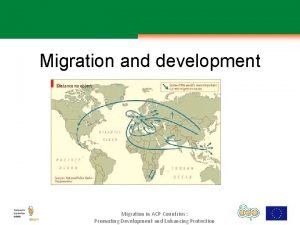Youth and Rural Development in ACP countries The

















- Slides: 17

Youth and Rural Development in ACP countries The Challenges of Youth Employment in ACP Countries: A Global Perspective Brussels Briefings 16 th June 2010 Bruno Losch

General Positioning p Youth in ACP countries like in many developing countries are often unemployed and they mainly participate in the informal labor market: they face high economic insecurity and poverty rates p Youth represent around 20% of the total population BUT more than 30% of the active population (EAP or 15 -64 group): => 37% in SSA, 32% and 28% in Pacific and Caribbean regions p Answering the youth employment challenge is critical for poverty reduction and the future of DCs p While targeted solutions are useful, they must be part of broad development strategies addressing the structural transformation of economies and societies

Basics 1: Demographic Transition p ACP countries face a large demographic growth: this is firstly the case of SSA and also of the Pacific while the Caribbean will slow down rapidly n In SSA: from 860 million people today, to 1. 3 billion in 2030 and 1. 8 billion in 2050 = + 103% = the last demographic transition in the world n In the Pacific: from around 10 million in 2010 and 17 million in 2050 = + 73% with sub-regional differences n In the Caribbean: from 40 million to 47 million in 2050 = +18% (but 80% of the population in Cuba, Haiti, Dominican Rep. ) 3

Basics 1: Demographic Transition p A rapidly changing demographic structure n n Activity ratio has remained extremely low throughout the past decades in SSA This structure weighted heavily on growth p Growth of the economically active population presents a significant opportunity… “the demographic dividend” p … but also a source of significant tensions if economies do not generate sufficient jobs 4

5

Basics 1: Demographic Transition p The present tensions on the labor market might intensify with the arrival of growing new cohorts: n n n p A “big push” in SSA: approximately 17 million / year at present, 24 million in 2025, 31 million in 2050 From 200, 000 to 300, 000 people between today and 2050 in the Pacific But 700, 000 new entrants / year in the Caribbean and already decreasing The ability of African economies to absorb this additional workforce is a crucial question 6

the World Bank 7

The example of Mali Evolution of Population 1960 -2025 (in Millions) p The yearly cohort of new entrants in the labor market is 300, 000 people today and will be 520, 000 in 15 years (240, 000 for rural EAP) n p Evolution of Active Population. 1960 -2025 (in Thds) The Malian economy will have to create 6, 2 millions “new jobs” These new entrants have already been born 8

Basics 2: Economic Transition p Developing countries are at different stages in the structural transformation process characterized by a progressive shift from agriculture to industries and services p Within this process, the role of agriculture in GDP and in employment decreases p The major vehicles of transformation are: n n The development of the rural non-farm economy Rural depopulation and migrations to cities (or abroad). The viability of this process implicates employment opportunities. 9

The Three Worlds of Agriculture (WDR 08 ) 10

The Evolutionary Path

Basics 2: Economic Transition p For most of the ACP countries the economic transition has been very slow p The population remains broadly rural and will remain rural till the 2030 s Agriculture has often a central role in GDP, trade, and particularly in employment p n p 60 -80% of the active population live from agriculture in SSA It means that most of the youth are rural and many are involved in agriculture 12


SSA’s Economic Transition: a Major Challenge p African economies are characterized by a low level of diversification n n p Rapid urbanization with a low level of industrialization Increased difficulties to develop a sufficient industrial sector in a context of strong international competition Consequences: n n n Manufacturing % GDP Limited creation of formal employment vs. absorption by the informal sector Economic and geopolitical constraints to international migration For a long time to come agriculture will remain the main employer Agriculture % GDP 14

Agriculture, Transition & Employment p The role of agriculture: n n Þ n p The lessons learnt from past transitions remind: n n p Contributes directly to food security, income creation and poverty reduction Is the major source of employment so far: this is too often forgotten in the existing debates It plays a central role in the economic transition the decisive role of farm income increase in the development of a rural demand Rural demand is the necessary step for the emergence of the rural non-farm economy (RNFE) Both agriculture and RNFE are critical for youth employment: their development will automatically facilitate the inclusion of young people 15

Prioritization, Targeting and Sequencing p Many targeted programs can be efficient for youth employment. However, there is a need for reengaging in development strategies based on long term vision, identification of opportunities and constraints , shared diagnostics and prioritization Þ the size of the yearly cohorts of young people entering the labor market is a strong reminder p Every country, region has its own development trajectory, comparative advantages and binding constraints, and heterogeneity is the rule: it means tailor-made policies instead of one-size-fits -all 16

Prioritization, Targeting and Sequencing p Two main issues can be raised: n n p A recurring binding constraints in many rural areas is risk: risk encourages self-consumption and prevents diversification. Addressing risks is critical. Many instruments can be finely designed and efficient but have a limited impact in terms of numbers: the objective is to address the big numbers through inclusive policies and programs, selecting options which are employment intensive. The future of youth is part of this general approach 17
 Veronika remisova
Veronika remisova Youth in action programme countries
Youth in action programme countries Chapter 9 agricultural transformation and rural development
Chapter 9 agricultural transformation and rural development Chapter 9 agricultural transformation and rural development
Chapter 9 agricultural transformation and rural development Ministry of agriculture and rural development cameroon
Ministry of agriculture and rural development cameroon Ecotourim
Ecotourim Agricultural transformation and rural development
Agricultural transformation and rural development Matthias langemeyer
Matthias langemeyer Rural development
Rural development Rural areas have of development drivers ed
Rural areas have of development drivers ed Usda rural development tifton ga
Usda rural development tifton ga Pradhan mantri krishi sinchayee yojana in kerala
Pradhan mantri krishi sinchayee yojana in kerala Ministry of rural development
Ministry of rural development Comprehensive rural development programme
Comprehensive rural development programme Kaavil farmfresh spices
Kaavil farmfresh spices Zila parishad
Zila parishad Rural development loan massachusetts
Rural development loan massachusetts Nyc department of youth
Nyc department of youth
